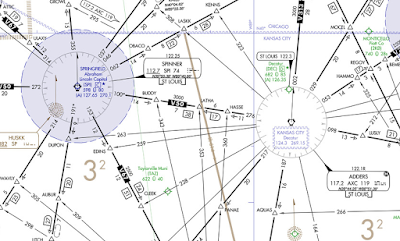What I'm talking about is an example like this, the Springfield, IL (KSPI) VOR/DME RWY 31:
Look at that leg starting at LATHA. It has the text "3100 NoPT to PUWGO 246 (7.9) and 296 (4.5)". It doesn't show a radial to fly off of LATHA, it just gives a heading. So what gives?
Instrument approach charts don't exist in a vacuum. Often to understand them, we must also refer to the appropriate enroute chart:
Notice that LATHA is sitting on V50 between AXC and SPI VORs, on the AXC R-276. To fly this approach, however, you are expected to fly heading 246 degrees from LATHA. This takes you OFF of the radial, and in fact you have no course guidance at all for this leg!
That's why it's called a "dead reckoning" leg. It's just a heading to fly. In this case, you will fly the heading 246 from LATHA until intercepting the SPI R-296 inbound on the approach. This should take about 7.9 nm according to the charted distance. Then you will fly another 4.5 nm on that R-296 until reaching PUWGO. The distances are approximate, of course, as wind drift will affect your actual track, but are there to give some idea of how long it should take for the intercept.
Notice there is a fix called (CFBVH) - with parentheses - at the intersection of the heading and the final approach course. This is known as a Computer Navigation Fix and is there solely for reference by GPS receivers and FMSes, helping them to align you on the proper course.
Now, you can imagine that with a 7.9 nm leg that has no course guidance, you could be pretty far off course if you have a strong crosswind - and you'd be right. Fortunately that is accounted for in the procedure design and the protected areas are HUGE, and get larger the farther away you get from the starting point.
You tend to find these more often on ILS procedures, as the localizer signal doesn't always point in a convenient direction. Two more examples are at Champaign-Urbana, IL (CMI) ILS or LOC RWY 32R (see the leg from NEWMY),
and the Salina, KS (KSLN) ILS or LOC RWY 35 (legs from both ANTON and GUTER).
There are many more examples, of course, but with ATC radar vectors, we fortunately don't have to fly them very often. Do you have any favorites? Let me know!




https://www.airnav.com/airport/KEUG
ReplyDeleteThe ILS 16L approach into KEUG starting at SHEDD has a dead reckoning leg. I've looked this term up online and couldn't find it and I don't remember seeing it in the IPH...Where did you find this term?
You're right, this type of leg is not mentioned in the IPH at all. I was actually looking for it a few days ago myself and couldn't find anything.
DeleteIt may have been in a previous version of the IPH, but I didn't see it in the 2007 edition either.
The only reference I've been able to find in an official publication is in the TERPS, the procedure design manual, FAAO 8260.3C, where paragraph 2-4-4 discusses the design methods for a DR leg. However, that's not exactly an easily digestable document nor are pilots expected to have any familiarity with it.
https://www.faa.gov/regulations_policies/orders_notices/index.cfm/go/document.information/documentID/1029266
Thanks for reading!
Russ
Thank you for your so cool post, it is useful, i love it very much. Please share with us more good articles.
ReplyDeleteCFI Course
Thanks John! I'm always looking for ideas, so if you have any topics you'd like me to discuss, just let me know.
DeleteRuss